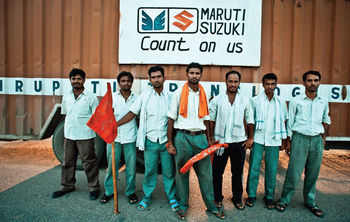Most trade unions in India have a political backing or allegiance. Although the MSWU went through the All India Trade Union Congress (AITUC), they are independent of them and not affiliated with any political party.
The historical context stems for years of oppression and repressive treatment laborers have encountered in India. This takes a new level altogether when the formation of trade unions is made extremely challenging by the labor union, which is highly corrupt. Even after the formation, the police and government make it difficult for them to normally function, by harassing the senior members and paying people off.
Labor Unions in India generally have faced a lot of adversity from the Modi government, with numerous workers' strikes occurring over the last few years. A lot of the issues stem from the government's reforming of labor laws, disinvestments in state-owned companies and foreign direct investment, adding a lot of job insecurity and severely undermining workers' rights in numerous regards. The MSWU is no different from this, as new laws have made it more challenging for labor union's to play a role in labor disputes.
These added problems makes this struggle all the more grueling.
The main Maruti Suzuki plant was in Gurgaon (neighboring New Delhi) and a new one was set up in Manesar (also nearby), where a lot of the young workers were transferred to along with the recruitment of new workers. There was a mix of permanent, contractual and intern workers.
The union was formed out of a need since the condition of workers was absolutely deplorable, working long hours and being squeezed to work extra, earning extremely low wages, and being roughly disciplined and discriminated against. When they tried forming an official labor union, the management tried to hoist the company union onto them, and along with the labor department, made it extremely difficult for them to get their own union. When their proposals were rejected, there were a series of strikes, and along with some leadership changes, they gathered support from small labor unions, university students etc. After a while, an official union was finally recognized by the labor department, with their main goal to be dealing with the struggles of both the permanent and contract workers.

A trend that had arisen over the last few decades was the excessive hiring of contract workers who were fired right as they were about to turn permanent. This was done to escape labor laws which make it difficult to fire permanent workers in times of economic downturn. This job insecurity, coupled with tough working conditions boiled over and resulted in an altercation with security causing a huge fire at the Manesar plant, where one person died and hundred were injured. After this, 500 employees were fired and 147 were arrested, with raids and searches being conducted by the police in neighboring villages and states.
After bail was denied for 3 years, a verdict was released where 13 MSWU members were given life imprisonment and 4 members given 5 years in jail. This has been given without adequate evidence of the incident, which the union is demanding a judicial inquiry into. The case has not been justly fought as the company has received plenty of police and government help. The union has been fighting against these injustices ever since.
The group is primarily composed of males aged 20-25, most of who belong to the first generation working class (backgrounds of peasant families in the neighboring areas whose land has been acquired).
The leadership structure here was extremely innovative and one of the first of its kind in India, which served as an important blueprint for future organizations. They had come up with a 'layered' system of leadership whereby there was no one particular leader, but certain levels they had established. They were ready to sacrifice the top to further their cause, as was actually done as well during the first round of protests when the top leadership was being threatened by the police and management and being offered hefty retirement packages. The union sensed this and cut them off, putting the next layer of leaders in charge.
They had a 1st, 2nd and 3rd layer and so on and so forth, with a strong communication chain set up.

